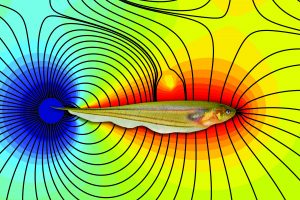
A team of researchers led by mechanical engineering professor Noah Cowan has successfully designed and tested a new system that could be used to help researchers and naturalists collect valuable environmental and wildlife data in sensitive natural habitats, such as in South America’s Amazon River basin.
Their study, published recently in Nature Scientific Reports, centered on weakly electric fish. Like electric eels, these fish emit electricity into the water, except they use much weaker signals to electronically communicate with each other and to gather information about their surroundings rather than stun their prey.
“The new system gives us a mechanism by which to measure, in their natural habitat, the free behavior of weakly electric fish,” says Cowan, a senior author of the paper. “In the long term, it actually gives us an opportunity to do things like environmental health monitoring. Basically, the electric fish could be used as a marker. We could monitor them over several years and see what their patterns are, in the same way that researchers have tracked other species like frogs, butterflies, and honeybees.”
Cowan’s team usually explores how land animals travel effectively through treacherous environments, with the goal of improving the design of ground vehicles and rescue robots. This type of data is typically collected through video recordings that can be slowed down and analyzed by computer programs. Analyzing the travel secrets of aquatic animals is a bit more complicated because conventional video cameras can’t track the creatures in murky water, which is often cluttered with roots and leaves.
So Cowan’s team, led by postdoc Manu Madhav and PhD student Ravi Jayakumar, developed a workaround: They built a grid of electrodes that served as a sort of electrical “video camera,” painting a piece-by-piece portrait of where the fish were swimming by “eavesdropping on their electrical signals,” notes Eric Fortune from the New Jersey Institute of Technology, a senior co-author of the study.
Cowan is confident that he and his colleagues have created a useful research tool. The next step involves deploying the system more widely throughout the Amazon River basin.
–Lisa Ercolano